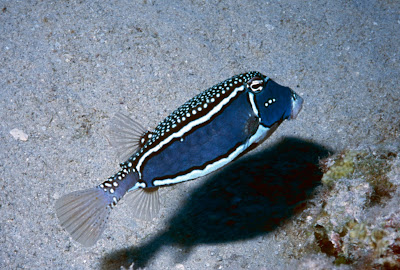Photos Copyright 2010 by Barry Fackler
A couple of weeks ago I posted a photo of a female Whitley's Boxfish. At the time, I mentioned that the male of the species was rarely seen but had beautiful blue coloration. For you, dear reader, I went through my slides and found an ancient photo of a male Whitley's that we saw years ago. The quality of the photo is poor due to the scanning process.
As you can see, the sexes differ drastically in appearance. This is an example of sexual dimorphism which Wikipedia describes as "the systematic difference in form between individuals of different sex in the same species". In many fish, the sexes are almost indistinguishable from one another. In some reef fish, though, the difference is spectacular. Examples include many species of wrasse and parrotfish.
The rationale for sexual dimorphism is a subject of debate but the leading theory is that it aids the male in attracting mates. A flashy, brightly- colored male will attract more mates than a dull, drab one. However, it seems that a flashy, brightly-colored male would also attract more predators too! Not a good scenario for propagating a species like the Whitley's Boxfish where males are already in short supply. The boxfish has an adaptation to deal with this as well - a strong toxin secreted through the skin which acts as an effective deterrent.


No comments:
Post a Comment